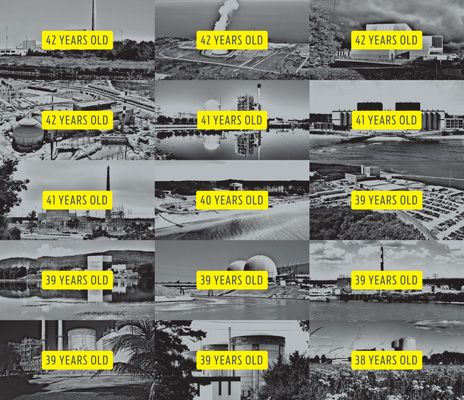Nuclear Power Plants Worldwide
Sixty years ago, on June 26, 1954, at Obninsk, Russia, the nuclear power plant APS-1 with a net electrical output of 5 MW was connected to the power grid, the world's first nuclear power plant that generated electricity for commercial use. On August 27, 1956 the first commercial nuclear power plant, Calder Hall 1, England, with a net electrical output of 50 MW was connected to the national grid.
Distribution of Worldwide Operational Reactor Age
As of March 11, 2014 in 31 countries 435 nuclear power plant units with an installed electric net capacity of about 372 GW are in operation and 72 plants with an installed capacity of 68 GW are in 15 countries under construction.
• Age distribution of nuclear reactors shut down worldwide | StatisticAs of end 2011 the total electricity production since 1951 amounts to 69,760 billion kWh. The cumulative operating experience amounted to 15,080 years by end of 2012.
Based on the 123 Nuclear Power Plants which have been switched off, the average (as well as median) age at shutdown was 22 years, with the oldest being 48 years old. The distribution of age of operational plants above indicates that a majority exceed the 22 year age, with a median and mode of 30 years, and may be living on borrowed time.
Britain
In Britain, Nuclear Reactors to Be Shut Down in Fault Investigation - NYTimes.coma-guide-to-nuclear-regulation-in-the-uk.pdf
EDF shuts down two UK nuclear plants amid safety fears - Telegraph
Nuclear Shutdowns Put Belgians and Britons on Blackout Alert - IEEE Spectrum
US-
Over the years, fundamental reactor structures can be damaged by radiation and the thermal and pressure extremes inherent in operation and fueling, rendering them brittle and vulnerable to cracks from work hardening.
Sixty years ago, when commercial nuclear reactors were in development, engineers couldn't say for sure how long a reactor vessel might last. Its 6- to 8-inch-thick steel walls are bombarded with radiation, and go through extreme heating and cooling cycles whenever the reactor is restarted—which happens every 18 or 24 months during the refueling process. (If one of those walls becomes brittle, it's necessary to shut down the reactor permanently, since replacing a reactor vessel requires dismantling half of the plant. Researchers are experimenting with technologies to repair damaged parts of the wall, but none of these methods has been deployed in a commercial reactor.)
::::
In the United States, the 1954 Atomic Energy Act (PDF) initially limited nuclear plant licenses to 40 years. As the first generation of nuclear reactors approached and surpassed the middle of their 40-year lifespan, the Nuclear Regulatory Commission published procedures in 1995 to offer license extensions. Today, most expiration dates have been put off by two decades, and there's talk of extending the limits up to 80 total years of operation. The possibility has split the scientific community, largely because of potentially undetectable effects of aging.
Fitness Tests for Old Nuclear Reactors - IEEE Spectrum
If the United States wants to continue relying on nuclear power to keep one out of five lightbulbs lit, the NRC needs to be assured that a sound technical basis exists to support a second round of reactor life extension. By about 2020, the NRC must decide if it needs to establish additional rules and standards for subsequent licenses to allow for operation to go from 60 to 80 years.NRC: Backgrounder on Decommissioning Nuclear Power Plants
Determining the Effects of Radiation on Aging Concrete Structures of Nuclear Reactors - 10243
Aging nuclear reactors get safety passes - US news - Environment | NBC News
AP IMPACT: US nuke regulators weaken safety rules
California
San Onofre Nuclear Plant Closing Leaves $500 Million Bill
CALPIRG Testifies In Front Of PUC: Consumers Shouldn’t Pay For Edison’s Mistakes | CALPIRG
Edison Con? San Onofre Nuclear Plant Owner Proposes Reactor Restart | MyFDL





No comments:
Post a Comment